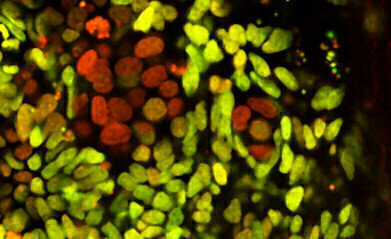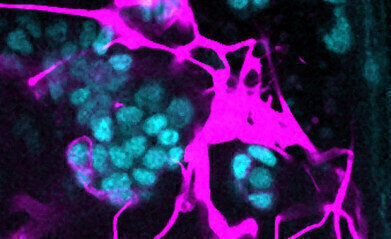News & Views
Resisting change: Stem Cells Remain Young
Feb 23 2016
Scientists at the European Molecular Biology Laboratory (EMBL), who have been comparing stem cells and those with a set structure, have come up with this ‘before and after’ image which could be thought of as stem cells’ equivalent of an advert for anti-wrinkle cream: ‘look how cells stay young!’ It shows that a molecule called microRNA-142 allows stem cells to remain unchanged, instead of growing into specialised cell types. Given the right conditions, stem cells with low levels of microRNA-142 (green, left) grow into neurons (pink, right). But stem cells with high levels of the molecule (red, left) remain unchanged (blue, right), the team at EMBL in Heidelberg, Germany, have found.
“It seems that this microRNA leaves the cells deaf to their environment: you can ‘throw’ whatever you want at them, and they don’t care: they carry on being stem cells,” says Pierre Neveu, who led the work.
The finding* could have implications for cancer treatment and regenerative medicine, as well as more fundamental research. Hanna Sladitschek, a PhD student in Neveu’s lab, found that this microRNA suppresses a gene that can turn cells into tumour cells; it also blocks two chain reactions that have also been linked to cancer. “So you could think of delivering the microRNA to cells to prevent tumours from spreading,” Neveu postulates.
For colleagues working in regenerative medicine, the knowledge could bring increased safety and efficiency. If researchers growing tissue from stem cells in the lab removed cells with high levels of miRNA-142, they would reduce the risk that the tissue they implant back into patients still contains stem cells, which can develop into tumours. Selecting which cells to keep based on their levels of miRNA-142 could also considerably shorten the time needed to grow such tissues.
*Published in Molecular Systems Biology on 21 December 2015. DOI: 10.15252/msb.20156525
Digital Edition
Lab Asia 31.2 April 2024
April 2024
In This Edition Chromatography Articles - Approaches to troubleshooting an SPE method for the analysis of oligonucleotides (pt i) - High-precision liquid flow processes demand full fluidic c...
View all digital editions
Events
Apr 24 2024 Jakarta, Indonesia
Apr 25 2024 Istanbul, Turkey
Apr 28 2024 Montreal, Quebec, Canada
May 05 2024 Seville, Spain
InformEx Zone at CPhl North America
May 07 2024 Pennsylvania, PA, USA



















